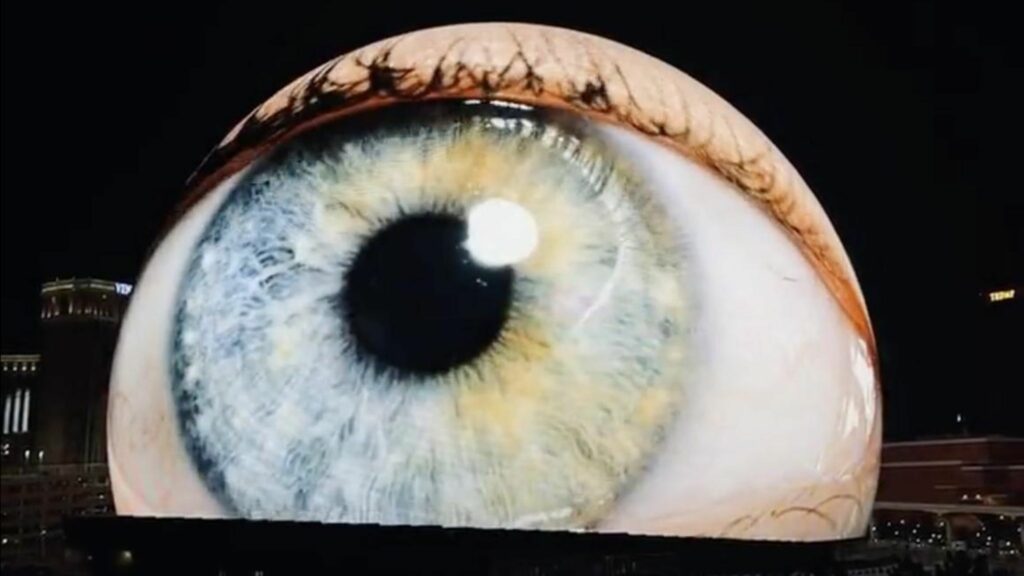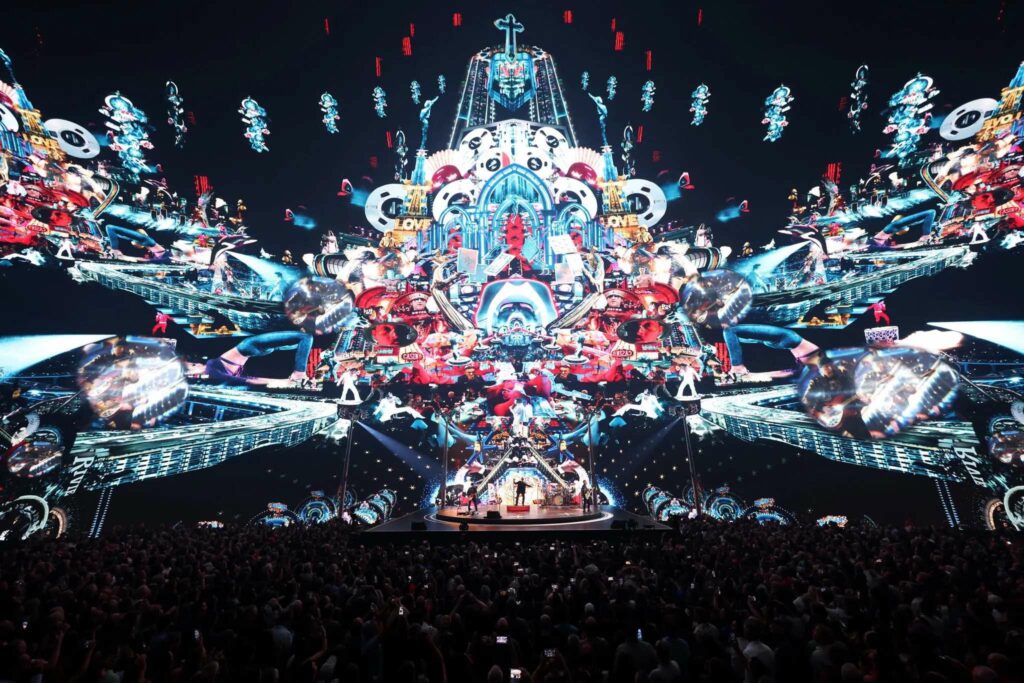The Sphere, a new platform

You can see the Sphere from the air as you fly into Las Vegas. It is a monumental globe wrapped in pixels — a spherical screen. One moment the building is a gigantic eyeball blinking, the next it is morphed into a slowly rotating basket ball thirty stories high, the next it is a crystalline Moon that feels as real as a planet. Part of the Sphere’s magic is its scale; it can be seen miles away. Its wizardly transformation from one whimsical appearance to another serves as a billboard. What it is advertising is the Sphere itself.
The inside of the giant globe is lined with an even finer video screen coated with 25 million tiny pixels. It is the largest hi-res screen in the world. When you stand or sit inside the Sphere’s cavernous cavity, your entire gaze is filled. As you look forward, or up, or to the side, you see images that surround you as clear as day. And since this screen wraps beyond the corners of your peripheral vision, you feel immersed in its fantasy. When the Sphere renders a vista of a desert mountain sunset, you feel as if you are right there in the dust at dusk. In short, the Sphere allows you to experience most of the magic of virtual reality without any goggles or glasses. That naked virtuality is exhilarating. And you experience it communally, with 38,000 other people at the same time. This social dimension makes it both more intimate and more like a spectacle.
Costing $2 billion to build, the Sphere is designed to be a next level venue for rock concerts, cinematic blockbusters way beyond IMAX, theatrical extravaganzas, and mass VR experiences. Besides its mind-blowing graphics, it can also create mind-blowing audio. Using new audio techniques (1,800 speakers) never before unleashed at this scale, every seat in the audience of the Sphere gets a targeted beam of sound tweaked for that seat. This beam of sound is so precise that someone sitting a few seats away could hear something entirely different (say a different language) and there would be no bleeding of sound between them. This precision location accuracy means that the resolution of the sound is as high as the graphics. Every person in the audience receives perfect sound, no matter where they are. It’s like hearing high fidelity stereo audio without earphones. Because you are sitting there without goggles or earphones, yet floating in realism, alongside thousands of others who are also present without visible technology, it feels magical.
Superficially the Sphere is an amped up light show. For decades big rock bands have filled arenas backed with huge displays, and state-of-the-art pyrotechnics. But these huge displays still only fill a small part of your forward vision. The Sphere in contrast, fills the world as far as you can see in any direction. Its architecture is similar to a planetarium; a half dome sits over a raked incline of seats. But the show in a planetarium is projected onto a screen; its images are pale and coarse, while the Sphere’s LEDs emit incredibly brilliant, crisp and luminescent visuals, and in such high resolution that the images appear to resolve in infinity. In addition, the patented sound beams, instead of a wall of sound, add up with the visuals to create an overwhelming impression of realism not found in any other medium.

The Sphere is also more than just an expanded IMAX. The dome screen is so bright that it lights up the entire audience plus anyone on the stage at its center. This stage lends a theatrical element to the venue’s strong cinematic nature. When musicians, actors, or presenters gather on the stage, they reveal the Sphere’s true enormous scale, and this also adds to its verisimilitude. The surface of the LED screen is so distant (150 feet) that your eyes are actually focused on far away things, rather than pretending to focus far while actually focused on a nearby screen. Unconsciously, this usual focusing conflict causes stress, while in the Sphere your eye/brain relax and you intuit the distance and scale, which makes the rendered world feel big. The high resolution means the movement of people, vehicles, nature in the distance, which are normally too small to be discerned in detail in most media, are now rendered in the same way you’d see them in real life. I call this singular feature a “distant intimacy,” and this furthers the uncanny realistic atmosphere.
The Sphere’s owners plan to replicate the Sphere many times, like suburban IMAX movie theaters, or stadium arenas. I understand that inclination because I think the Sphere represents a new platform, a new media. It is part cinema, part theater, part VR, part concert stadium, and part Times Square. So far, all this tech has been used to amplify the WOW. It’s really good for playing around with scale, for generating trippy experiences, and grand hallucinations with intense realism. The legendary band U2 launched the venue’s opening evening with a far-out show of psychedelic visions and rock and roll. Clips from the concert spread virally as the show unfolded. Quickly following them a week later, cinematographer Darren Aronofsky will debut the Sphere’s cinematic talents with “Postcards from Earth”. His team developed special cameras to record life semi-spherically in order to maximize the field of vision seen on the inner dome. The shows are spectacular, if not outright spectacles. It remains to be seen whether the Sphere can make people cry, and walk out moved in their souls.
This is just the beginning. The very first movies emphasized the wow factor — locomotives rushing right at the audience. To date one band and one movie director have had a chance to create content for the Sphere. It will take a while to figure out exactly what excels on this new platform. The capabilities of its screens and audio, driven by immense computation, suggest that the 3D engines powering todays’ video games and VR might be able to create worlds that could be explored in common by an audience in ways that neither solo games, VR, or movies can do. I could imagine new varieties of e-sports taking off in the Sphere.
The Sphere does not work scaled down — that is just VR. Because it needs to be physically big, you will not have one in your bedroom. So you’ll have to travel to somewhere to visit one. It is easy to believe that local movie theaters might be rebuilt as Spheres (at least on the inside) to attract all the people who no longer go to theaters (like me) because their 80-inch screen at home is just as good. The Sphere offers an experience that will be hard to duplicate outside it. A crucial large factor in that experience is its communal nature. The visceral power of tens of thousands of people sharing the same emotions will be worth the price of entry. The more we sit at our desks along all day, the more valuable community entertainment will become. Concert and sports stadiums offer communal emotion, but in a very limited emotional range. The Sphere platform has the opportunity to create content that offers communal emotions that soar in many other directions.
The Sphere is worth going out of your way to experience. In the feverish hysteria during the Sphere’s opening concert someone tweeted, “Late stage empires don’t build things this extraordinary.” I would not go that far, but without a doubt it is a massive technological achievement. It is too early to tell if it will be a marvel like the singular Pantheon, or one of many like Roman colosseums.


